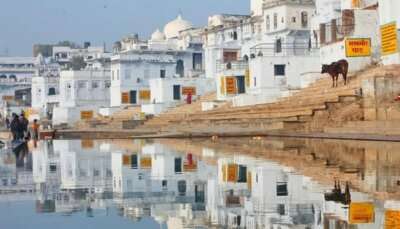Embark On A Journey To The Gandhola Monastery A Sanctuary Of Spiritual Serenity In 2026
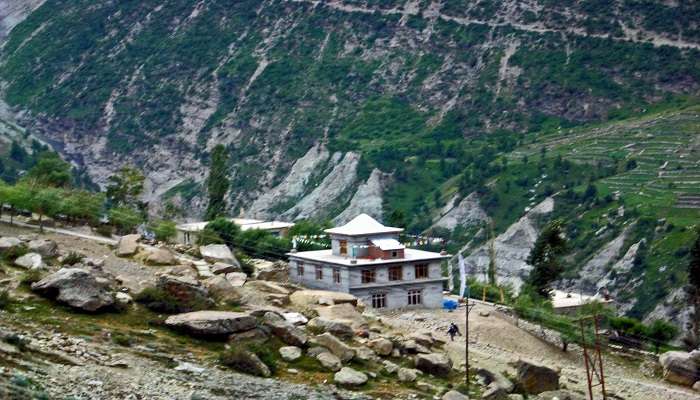
Gandhola Monastery is about 18 kilometres before Keylong in Lahaul and Spiti district, Himachal Pradesh, India, on the road from Manali, Himachal Pradesh. It is located on a hill above Tupchiling Village at the sacred junction of the Chandra and Bhaga rivers, forming the Chenab together. Every year, tourists flock to the monastery to view its 7-storey forts, wooden idols of Buddha and black stone images of various goddesses against the backdrop of icy mountains. River. We’ve curated a list of all you need to know about Gandhola Monastery when you decide to experience Himachal Pradesh’s magic.
About Gandhola Monastery
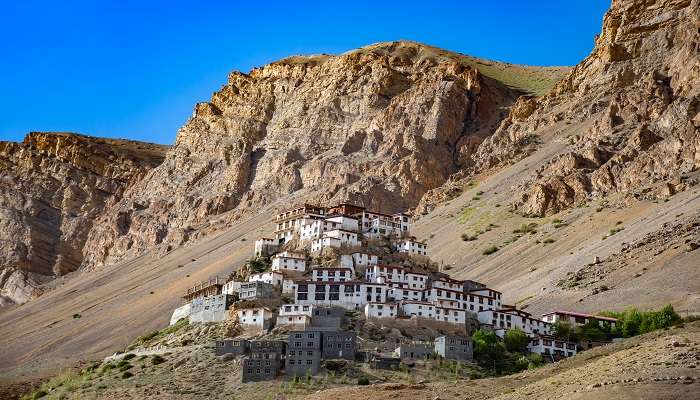
The Mighty Guru Ghantal Monastery is the most popular destination for travellers in the Lahaul region. Surrounded by mountains and rolling dunes, the monastery spells magic. It is deemed to be the oldest monastery in the Lahaul region. Legends say that Guru Rinpoche established the monastery in the 8th century CE. In 1857, historians discovered a copper goblet, the oldest example of metalwork from the 1st century. The latter instance depicted that the Buddhist civilisation was also advanced then. Perched at an elevation of 3160 m on the rocky cliffs of Tupchiling village, the mighty monastery is close to the point where there is a confluence of Chandra and Bhaga River. The order of Drukpa monks and nuns maintains Guru Ghantal Monastery. Like all other monasteries of the order, it owes a loyalty to His Holiness the 12th Gyalwang Drukpa, or Drukchen Rinpoche.
The monastery houses some very precious religious treasures with excellent architectural specimens. 1959 the monastery underwent a major renovation, but its charm remained intact. A unique feature of the Guru Ghantal monastery is the wooden idols of the Buddha, said to have been installed by the monk Rinchen Zangpo. Within the shrine, there are many other possessions like sculptures made of clay, numerous idols of Guru Padmasambhava, Brijeshwari Devi and other lamas, an image of Goddess Kali cast in black stone, paintings, murals and white marble heads of Avalokitesvara which the founders installed. On the outskirts of the monastery is a seven-storey fort made of stone and timber. The fort was allegedly built by Raja Man Singh, who was once the ruler of the Kullu kingdom; it even houses a prized sword.
Must Read: Trekking Near Manali
Architecture Of Gandhola Monastery
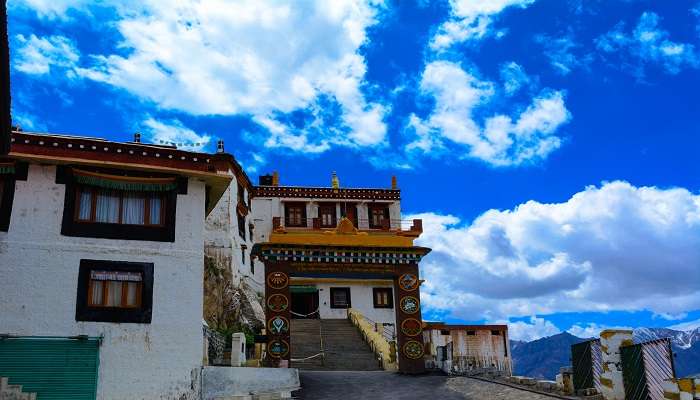
The Gandhola Monastery, or the Guru Ganthal Gompa, is more than 800 years old, and what sets it apart from all the other gompas is its wooden idols instead of the usual clay ones. The gompa comprises distinct sculptures of Guru Padmasambhava, Brijeswari Devi and other lamas. There are myriad paintings, murals and a black-stone sculpture of the Goddess Kali. A damaged white marble head of Avalokitesvara, installed by the monastery’s founder, is found here. Avalokitesvara, also known as Padmapani, is a bodhisattva who embodies the compassion of all Buddhas. Portrayed in different cultures as either male or female, Avalokitesvara is one of the more widely revered bodhisattvas in mainstream Mahayana Buddhism and unofficially in Theravada Buddhism.
The image of Avalokitesvara is kept in the monastery itself and is claimed to date back to the time of Nagarjuna in the 2nd century AD. In 1857, historian Mary Hay discovered a copper goblet, which is stated to be the oldest example of excellent metalwork craftsmanship by Buddhists from the 1st century. This is known as the Kulu Vase, now in the British Museum. The Gandhola Monastery is considered part of a larger complex of structures; the present structure is two-storied instead of the seven-storied grandeur of alternating layers of stone and timber, which was once the seat of the local king. Gandhola Monastery is the only monastery in the region other than Sani Monastery in Zanskar, which has a history that is claimed to go back to Kushana times. The Gandhola Monastery underwent extensive repairs, and a small pagoda roof of Kangra slates was added in 1959. The Gandhola Monastery is an architectural masterpiece. The peculiar works of art give it a unique factor that attracts tourists worldwide. The Tupchiling village is a 4-kilometre walk from the hilltop monastery. The monastery houses some very precious religious treasures with excellent architectural specimens.
Landscape Around The Monastery
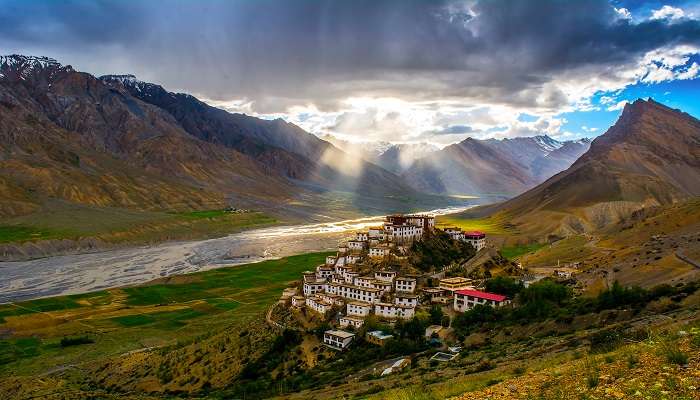
Beyond the walls of Gandhola Monastery lies a vast expanse of rugged terrain and breathtaking vistas waiting to be explored. Visitors can embark on trekking expeditions, nature walks, and pilgrimage circuits that lead to sacred sites, hidden caves, and panoramic viewpoints overlooking the valley. Along the way, travellers encounter nomadic herders, friendly villagers, and elusive wildlife, each adding to the richness and diversity of the Spiti experience.
Suggested Read: Best Places To Visit In Himachal Pradesh
How To Reach The Monastery
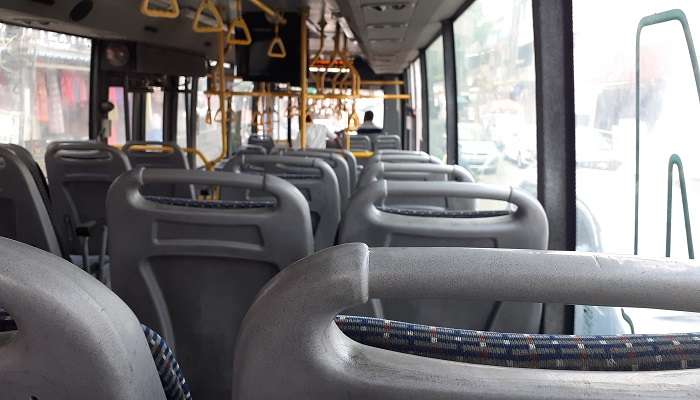
Being situated at very high elevations in the Himalayas and considered the remotest region in Himachal Pradesh, Lahaul and Spiti are challenging to access. However, the valley is still accessible by road from Manali via Rohtang Pass and Kinnaur.
By Air: The nearest airport to this region is the Bhuntar Airport, near Kullu (245 km away). One must go to Manali from Bhuntar and hire a bus or cab to reach Lahaul & Spiti Valley. The nearest international airport to Lahaul & Spiti Valley is in Chandigarh, 495 km away. There are buses to Reckong Peo and Manali, from where the traveller has to board a bus to Kaza. For obvious reasons, being situated at very high elevations in the Himalayas and considered the remotest region in Himachal Pradesh, Lahaul & Spiti are challenging to access. The valley is still accessible by road from Manali via Rohtang Pass and Kinnaur.
By Rail: The nearest railway stations to the Lahaul & Spiti district are the Jogindernagar Railway Station (360 km away) and the Shimla Railway Station (416 km away). Buses and taxis are available to take you to Spiti Valley from here. The Kalka Railway station, which enjoys good connectivity with many parts of India, is 485 km away.
By Road: This is the best way to reach Lahaul & Spiti. 2 roads connect the district with the rest of Himachal Pradesh. One route is from Shimla to Kaza in Spiti Valley through Reckong Peo (412 km, 20 hours), and the other route follows the same road from Shimla to Keylong in Lahaul (375 km, 18 hours). One can also reach Lahaul and Spiti Valley from Manali through the Rohtang Pass and the Kunzum Pass. However, this road remains closed for most of the year (9 months) due to heavy snowfall.
Further Read: Manali To Leh road Trip.
Now that you have a list of things to remember for your next vacation, including seeing the beautiful Gandhola monastery, make sure you plan your trip to Himachal Pradesh to these fabulous spots for the experience of a lifetime. Don’t miss out on these opportunities; book your tickets now!
For our editorial codes of conduct and copyright disclaimer, please click here.
Cover Image Credit: John Hill for Wikimedia Commons
Frequently Asked Questions About Gandhola Monastery
Where is Gandhola Monastery located?
Gandhola Monastery is situated in the Lahaul Valley of Himachal Pradesh, India. It's perched on a hilltop overlooking the confluence of the Chandra and Bhaga rivers, about 18 km from Keylong.
What's the best time to visit Gandhola Monastery?
The best time to visit is from June to September when the weather is milder and the roads are clear. The monastery is often inaccessible during winter due to heavy snowfall.
What makes Gandhola Monastery unique?
Gandhola is one of the oldest monasteries in the region, dating back to the 8th century. It's known for its distinct architecture, which blends Tibetan and Indian styles and houses rare Buddhist artefacts and ancient scriptures.
Are there any special festivals celebrated at Gandhola Monastery?
Yes, the monastery hosts an annual festival called Gandhola Mela in July or August. It features colourful mask dances, religious ceremonies, and local cultural performances.
What should visitors keep in mind when visiting Gandhola Monastery?
Respect local customs and dress modestly. Photography may be restricted in certain areas. Due to its remote location, it's advisable to arrange transportation in advance and be prepared for basic amenities.
People Also Read:
Namgyal Monastery Sherabling Monastery Ritigala Forest Monastery

Unveil the hidden treasures of the globe and turn every travel dream into reality. As a Content Writer, I am passionate enough to craft stories from ancient wonders to modern marvels. My words paint the picture-perfect itinerary for unforgettable experiences. Let my words be your trusted guide to immerse in the diverse culture and discover the beauty of the unknown.




